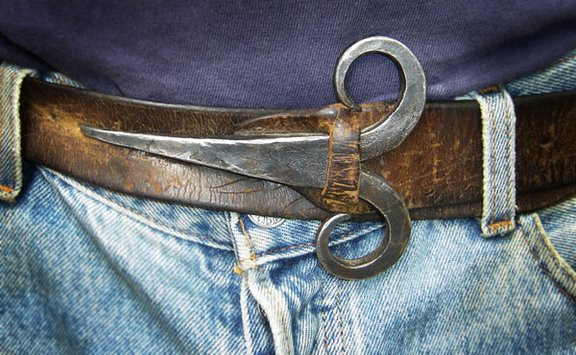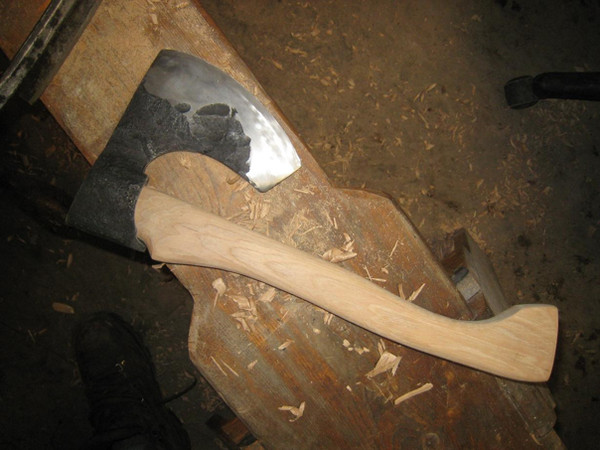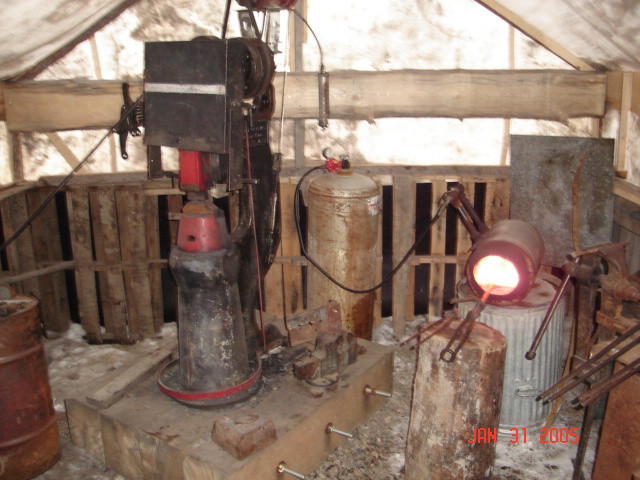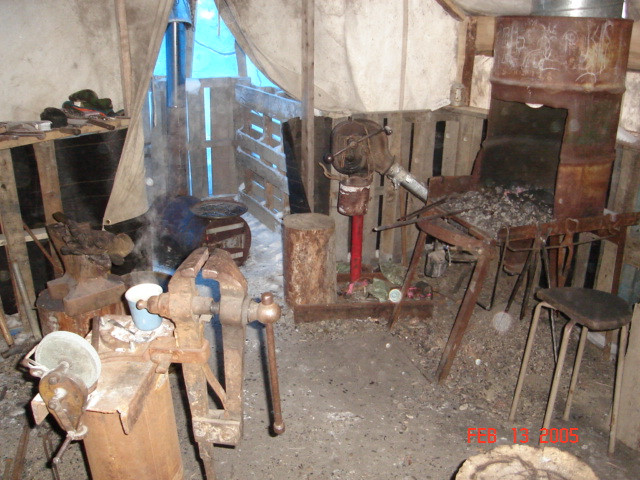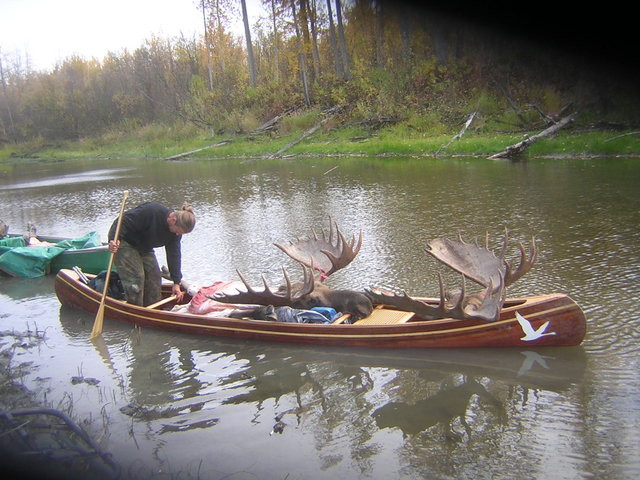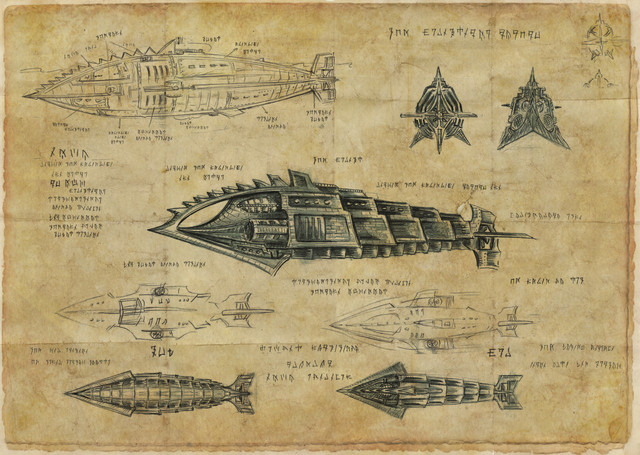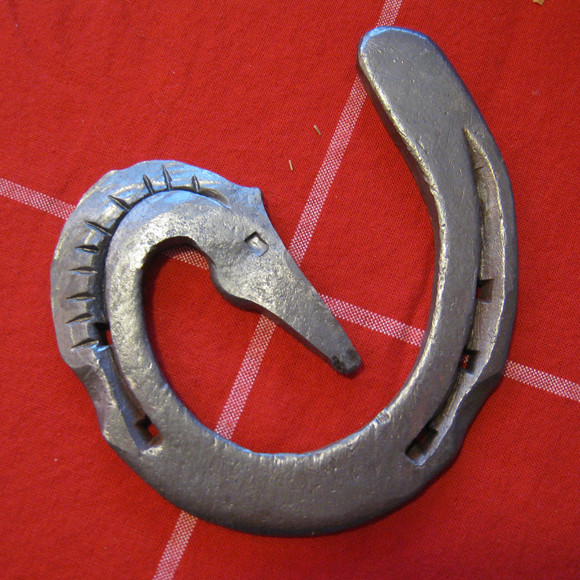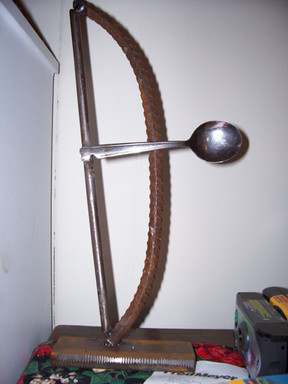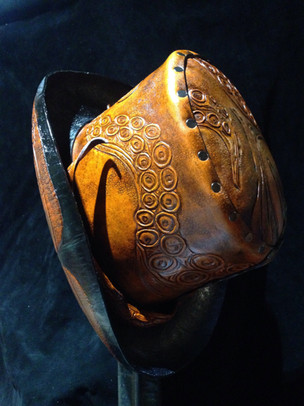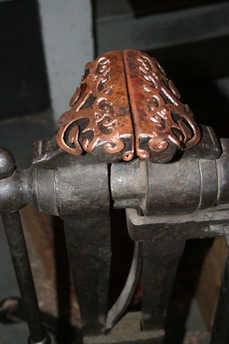HOME | DD
 jakepog — pattern-welded dagger
jakepog — pattern-welded dagger

Published: 2008-03-01 23:11:05 +0000 UTC; Views: 1062; Favourites: 4; Downloads: 57
Redirect to original
Description
This is NOT my work.But it did sort of come out of my shop.A good friend stopped by,and while we were BS-ing about laminating steel,i grabbed a snowmachine drive chain,fluxed and welded 4 parts of it together,and folded the billet once,all for shits and grins.Don drug it home and ground it,and to his(and mine)surprise there were no voids at all,so that's what's become of it afterwards.Ebony scales,bronze pins.Neither of us had any etchant handy,but the diversity of material is so great,that you can see the elongated rollers,alternating from side to side like a set of tracks,with a naked eye(but not with my camera)Related content
Comments: 14

If you are looking for hardware or objects to make billet, I suggest experimenting with steel cable (preferably 1” to 3/4” diameter) used for suspension bridge and elevator.
It’s generally called cable damascus, and billet made of cable by itself has very distinctive pattern different from laminate made of stacked flat bars.
I’m assuming you’re forging these objects and hardware into bar stock if you were to use them to produce laminate by stacked billet.
But I highly recommend using flat bar stock supplied by most knife making supply stores, or distributors who does business in small quantities.
Reason behind using bar stock is that these it will save both time and labor to prepare billet for laminating.
Also steels commonly used for producing laminated steel are available in size and thickness ideal for the purpose.
But if you have your mind set on using available resources found in shop, I would start with laminating 5160 and file steel.
I think 5160 has enough Cr (0.7-0.9%) and this may be enough to create contrast if laminated with much simpler low alloy steel such as file steel.
S7 seems to be very promising for purpose of contrast due to its higher Cr contents than 5160 steel, but I can’t tell you much since S7 isn’t commonly available steel to work with.
From looking at composition and its application, S7 seem to be a good steel to make edged tool by itself.
Here is another consideration. S7/5160 mix sounds like something to experiment with. Although 5160 has over 0.7% Cr, S7 steel has over 3 times Cr than 5160 steel.
I have a doubt that this combination could possibly produce good contrast since both steel having properties resilient to etching.
But if it does work, I think this combination might have advantages found in both work properties in forging, and heat treating since both steel are very similar to each other, except S7 having +3% Cr found in composition.
I have strictly made laminated steel with O-1/15N20, and 1084/15N20 steels. I wish I could be more help on working with 5160, but my only experience with 5160 is forging blade.
Whichever source of steel you choose to use to make laminated steel from, it’s very important you experiment with at least first two possible combinations (5160/file steel, and S7/file steel). I think what’s most important is whatever the method or materials works best for you. If you have any question just let me know.
👍: 0 ⏩: 1

Thank you very much.I've forge-welded cable before,for someone.Was easy to do,and did have a neat pattern(a mystery to me-what contrasts?The carbide exclusions?The decarburised weld-lines?Surely it's a one-alloy product?).Buying components for the billet would of course be ideal,in many respects,and maybe what will do for a couple of Don's knife blanks.For my hardware deal,i just plain can't afford to-my forge is my only source of income,and this is strictly a long-term speculation,will be lucky to afford the fuel.Also,i'm affiliated with a fabricator friend here,and have access to a 2" by 72" belt grinder w/a variety of belts,and other tools for laminate preparation,even a legit electrical tempering oven.What i do sorely lack is a pyrometer-need to research that Radio-Shack thermo-couple/volt meter combination,or see where to order the gun type,if accurate enough.But without one the heat-treating is not the same.Especially that i work in ambient light.I do have a small qty of 1095-what would be a good alloy to complement it?Also have some old,industrial "wrought-iron"-is that ever used in a laminate?And if so,at least in knife-making,how do mechanics of sharpening work,with such difference in hardness?Would like to ask you also about some SS,outboard motor output shafts,used here for tool-making,but know nothing about the composition-just have to assume med-C content,the objective being the impact resistance.It's a beautiful,fine-grained,consistent material,and moves very slowly under my hand-hammer.So laminating it may be strange-moving slower it would probably be stressing the weld-joints...
👍: 0 ⏩: 1

It’s definitely fun way of learning how to bond steels together while cable can produce beautiful pattern by itself.
A contrast you find on billet made of steel cable is due to decarburized structure surrounding around wire and weld seam.
If you were to use 1095, I suggest combining with tool steel that is richer in alloy than 10XX steel.
What most producers look for is higher alloy steel with elements containing sufficient amount of Cr or/and Ni in its composition.
Although these elements are added for purposes such as improving wear resistance. What we are concerned for contrasting is its property to resist corrosion than contrasting steel.
Commonly selected steel for this purpose is 15N20. This is 1075 steel with slight Ni found in its composition. Slight enough to make contrast with 10XX tool steel.
That is the reason why this pair has been so popular since it’s a very predictable steel to work with, while there are many suppliers who keeps them in stock in size/shape useful for making laminate.
I think best bet for you is to try small sample with 1095 and 5160 mix. Steel with higher Cr contents would be ideal, but I believe this combination will likely be able to reveal contrast.
But I have a concern with this mix due to differences in its property in heat treating. Both 1095 and 5160 can be quenched in oil, but Mn found in 5160 could cause problem with annealing process.
Another consideration for steel selection is carbon contents found in steel. Usually simpler high carbon steel (10XX) is used with mild steel. You’ll be able to bond 1095 and mild steel or wrought iron with ease.
I’ve made a laminate out of scrap 1084 and construction steel while back and you will be able to draw out contrast. I didn’t even bother experimenting with heat treating the billet since all I wanted was to see what degree of contrast such combination can produce.
Evidently high C and low C steel mix has an issue with carbon migration. I’ve been told this can be avoided by carefully monitoring both bonding and forging temperature, but I must say it would take some practice to produce a billet that is useful for producing cutlery.
Otherwise you can try with non-ferrous metals. Pure nickel works well, but most producers have moved away from using pure Ni for several reasons. First being rising price, and secondly, because most prefers using both steels that will produce hardened edge without drastic difference.
My friend has made Ni/1084 laminate somewhere between 120 and 180 layers. It did have difference in how cutting feels (especially at very thin edge), and I did notice difference in sharpening blade than a blade made of homogenous steel. But for use in everyday purposes, I see no problem with such laminate.
I’ve seen laminate made of mild steel/copper/brass mix. This laminate was used as a skin for samai-construction blade. Maybe this is something to consider too. You can make a laminate out of 5160/mild steel and fold a laminate with 5160 as a core. This way you can heat treat such composite blade as 5160, and having chance of losing its C contents is reduced to minimal since when core is added, that is your last laminating process before forging or grinding laminate into a blade.
As far as stainless steel used to make laminate, I would stay away from it. Forging stainless steel alone is a very hectic labor. Also stainless steel has such narrow temperature range to work with.
If I were you I would start with small batches of billet out of most abundant steel you have in shop, and experiment with it. It’s a good way to learn to be able to make clean and solid laminate while you can find a laminate that work out best for your concerns with both contrasting and producing desirable steel for purpose of making knives.
👍: 0 ⏩: 1

Amazing.What a complex world this pattern-welding is....several,really.Feel like all this is crucial for understanding steel in general,even plain forging-wise.Cannot thank you enough,will save all this and keep refering to it.Ever since i gained any ability to weld,can't keep away from it,in any form.Welds in joinery really add visual quality as well as the engineering diversity,an ability to join even the dissimilar components is crucial,and opens such design vistas...I'm a very poorly organised shop-as of yet to (a)put together a side-blast to use the poor quality local coal,(b)look into my propane forge to see if with some tinkering it would come up to welding heat,(c)build the charcoal retort/shop heater combination.Meanwhile i dump all the forge's income into the store-boughten fuel,but what wonderful metallurgical coal that is-pure,as the driven snow,even a very old fire stays clean...
👍: 0 ⏩: 1

You’re very welcome.
I find this craft very interesting too. I wish there are more references on the subject.
I’ve found small amount of references pointing toward producing laminated steel based on method of forging used by smith.
But best way to learn the craft is act of making itself and I find it very fun to do.
Heat source for producing laminate steel is very important.
Both coal and gas forge is capable of producing enough heat for laminate steel.
I use atmospheric forge and it does work very well even though many bladesmiths prefer using forced air gas forge for its output.
Flux will ruin insulation materials inside your forge, so be sure to put steel plate under where billet will be placed.
👍: 0 ⏩: 1

I have a two-burner atmospheric that works great-but i suspect not hot enough.It MAY weld alloy,mild-no way,not at the lower-to- medium yellows that i use with the coal.(but no point in even saying anything before i get a pyrometer).I have collected plenty of info to start some charcoal experiments and due to get off my duff with it any day now.Allegedly,the coniferous woods are great for welding as they release energy all at once,while the harder,deciduous(?)trees are better for forging.The ducks nest in my coal set-up is non too large,and at least with the blade-making it would really help to come up with a blank large enough to allow for some heat-treating experimentation.I'm deeply greatfull to you for your generous input,hope very much to justify it.As usual,the spring is catching me with my pants down,in the middle of this fascinating laminate experiment,suddenly an opportunity to teach a basic blacksmithing course came my way through the local u.extension,and also another aspect of metallurgy altogether-teaching myself to operate a vertical mill,as me and a friend are attempting to build a steam-engine,virtually from scratch,critically underfunded...and since it's already obvious that i have way too much going on,might as well confess that an attempt to cast bronze,using my propane forge,is also in the works....
👍: 0 ⏩: 0

That's a very clean coffin handle dagger.
I've seen few laminates made from motorcycle chain, but it seems like you and your buddy have found a good alternative for making a chain laminate.
As Silver11k suggested, etching can further reveal patterns on the blade. I suggest using ferric chloride (FeCl3), you'll find bottles as a circuit board etchant at a local Radioshack.
Sulferic acid works great, but you have better chance finding FeCL3 with ease.
I find 1:3 ratio of ferric chloride:water works well. It's a very mild mixture (but enough to cause skin irritation), but I feel slow etching does seem to reveal best result than at much more corrosive rate. You can try at different mixture and find what works best for you.
Just make sure to use distilled water at room temperature. Tap water (depending on region) seem to affect etching in some cases.
And don't forget to have chemical to neutralize acid. Many people neutralize with windex or a window cleaner with amonia. I use it to initially to neutralize acid once laminate is pulled out from etchant.
But I always finish with submerging etched laminate in boiling water/baking soda mix for 10 minuites or so to make sure there are no residue left on laminate.
A knifemaker once gave me a tip on how to get rid of corrosions caused by flux residue from soldering guard. I find method effective on etched laminate as well.
👍: 0 ⏩: 1

I'm most greatful to you for taking the time and replying at such lengh.Will continue experimenting with the lamination,so appreciate the info very much.The man who made the dagger is an old-timer with considerable knife-making experience,however never with composite.I would like to eventually come up with some quality billets for him,structurally,rather then visually,and the opposite for myself-for forging hardware and trinkets,since i do no blade-smithing.So would like to cover as much of the pattern-welding spectrum as i can.FeClO4(?)can no longer be had at RadioShack,and hazmat charges are very severe here,so we'll probably experiment with muriatic and sulfuric from old batteries.Thanks again,Jake.
👍: 0 ⏩: 2

That's interesting.... Ferric Chloride is what gives most of my pots their color! I will use it til I can't get away with it anymore!
👍: 0 ⏩: 0

You're very welcome. It's a very addictive craft which is both challenging and rewarding. And I also like to discuss about producing laminate steel with those who are interested in them.
Car battery seems like a good alternative source for etchant.
I haven't purchased a bottle of FeCl3 since 06, and I wouldn't be surprised if a local Radioshack has stopped supplying circuit board etchant too.
👍: 0 ⏩: 1

Laminating is a strange business to me,who only had an interest in controlled hand-forging.But the wrought iron,that all the technique is based upon,is almost impossible to find,and i'm not rich and famous enough to mail-order it from England.Meanwhile,the post-industrial alloy possibilities are amazing-S7 from jackhammer bits,5160 from (old)truck springs,1 and 1.25`C files...you name it,and that's the stuff i already have...so drifting in that direction naturally.My interest in it is primarily non-structural,so thinking very hard of what hardware/objects would look good laminated and etched....
👍: 0 ⏩: 0

You should give it a bath in sulfuric acid to make the structure better visual.
👍: 0 ⏩: 1

Thanks for that,and also for the fav-my friend who made that will be pleased that someone as experienced as yourself has liked his knife.
👍: 0 ⏩: 1

You're welcome and greetings to your friend.
👍: 0 ⏩: 0
